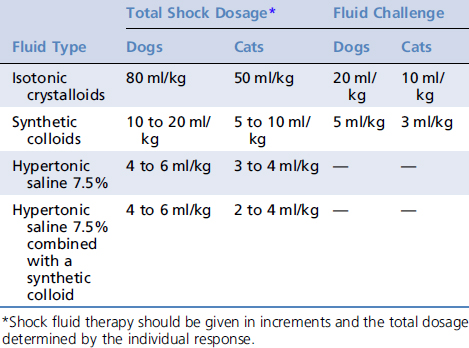Chapter 65 Shock Fluids and Fluid Challenge
SHOCK
The primary goal of shock therapy is to improve delivery of oxygen and other nutrients to metabolically active cells. Intravenous fluid therapy is essential in the resuscitation of patients with hypovolemic, distributive, and obstructive shock.3,4 There may be a role for fluid therapy in some specific instances of cardiogenic shock, but it must be administered with caution and requires intensive monitoring (see Chapter 35, Cardiogenic Shock).
ISOTONIC CRYSTALLOIDS
The composition of isotonic (or nearly isotonic) crystalloid fluids is similar to that of extracellular fluid. They have sodium concentrations in the 130 to 154 mEq/L range and concentrations of other ions (potassium, magnesium, calcium) similar to those in extracellular fluids, and may contain bicarbonate-like anions (Table 65-1).
Physiology
Because of the fairly rapid distribution out of the vascular space, isotonic crystalloids must be administered at rapid rates to get the desired vascular volume expansion. Isotonic crystalloids have little effect on intracellular volume (see Chapter 64, Daily Intravenous Fluid Therapy).
Fluid Prescription
The estimated dosage of isotonic crystalloids for treating shock is equal to the patient’s healthy blood volume (approximately 80 ml/kg for dogs, 50 ml/kg for cats). The actual fluid requirements of each patient will vary and must be prescribed individually. The total amount administered depends on the response to treatment and is usually one half to one blood volume (see Table 65-1). One strategy is to set up the fluid delivery system to deliver the prescribed amount in 20 minutes, and to slow or discontinue the infusion if the tissue perfusion parameters improve before the end of the infusion.
COLLOIDS
Physiology
Synthetic colloids redistribute into the interstitial space at a much lower ratio than the isotonic crystalloid fluids. They are expected to increase serum colloid osmotic pressure, which will lead to movement of fluid from the interstitial space into the vascular space. Consequently, colloid administration will increase blood volume by an amount greater than the infused volume. This means that effective resuscitation may be possible by administering smaller volumes. When the full dose of 20 ml/kg was administered in 5 minutes to experimental healthy dogs, blood volume was increased by 25% at the end of the infusion, 36% after 30 minutes, and 26% after 4 hours.5 These fluids are isoosmotic, so there is little effect on intracellular volume (see Chapter 64, Daily Intravenous Fluid Therapy).
Stay updated, free articles. Join our Telegram channel

Full access? Get Clinical Tree



